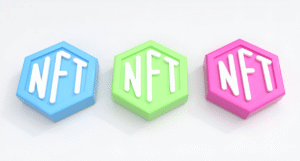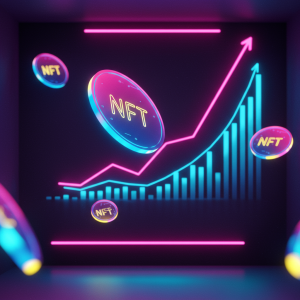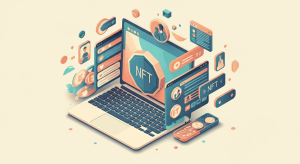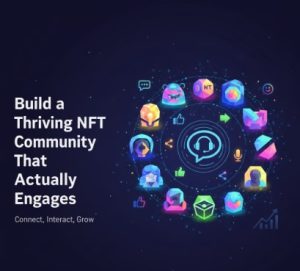Digital Identity Revolution: How NFT Profile Pictures are Reshaping Web3 Presence

The humble profile picture occupies perhaps the most valuable digital real estate in our online lives. That small circular image represents you across digital spaces, serving as your visual handshake in an increasingly virtual world. The evolution from casual smartphone photos to carefully curated avatars reveals deeper currents in how we construct identity online. Now, NFT profile pictures (PFPs) have emerged as a fascinating intersection of digital identity, community membership, and financial investment uniquely enabled by blockchain technology.
The Evolution of Digital Self-Representation
Digital identity expression has transformed dramatically since early internet days. The progression from anonymous usernames to real photos to carefully crafted avatars reflects our changing relationship with online spaces. Early internet users maintained strict separation between physical and digital identities, often using pseudonyms and fictional representations to navigate online communities.
As social media platforms proliferated, they pushed toward “authentic” representation—typically meaning real names and actual photographs. This drive for authenticity served platform business models but created significant tensions around privacy, safety, and self-determination. Many users found themselves caught between platform requirements and personal comfort levels around self-disclosure.
NFT profile pictures represent the next evolutionary stage—combining the pseudonymous protection of avatars with verifiable ownership and community signaling impossible in previous eras. These images serve multiple simultaneous functions: visual identification, community membership badges, investment vehicles, and technological demonstrations.
The Unique Proposition of NFT PFPs
NFT profile pictures differ fundamentally from conventional digital avatars through verifiable ownership secured on blockchain systems. This ownership layer transforms seemingly simple images into multidimensional assets with unique properties.
The concept of digital scarcity represents a dramatic shift from previous paradigms where digital images existed as infinitely reproducible files. While anyone can screenshot an NFT image, blockchain verification creates consensus around legitimate ownership. This verification mechanism doesn’t prevent visual reproduction but establishes recognized provenance within digital communities that value such distinctions.
Community membership signaling emerges as perhaps the most significant social function of PFP projects. Owning a Bored Ape, CryptoPunk, or Azuki functions similarly to wearing specific clothing brands, supporting particular sports teams, or displaying university affiliations in physical contexts. These visual signals communicate values, interests, and status to informed observers while remaining meaningless to those outside relevant communities.
Attribution verification solves longstanding digital identity challenges. When Twitter implemented NFT verification for profile pictures, it established a fundamentally new pattern for confirming connections between individuals and their digital assets. This verification system allows instantaneous authentication impossible in previous digital environments where anyone could use any image without accountability.
Community Formation Around PFP Collections
The social dimensions of NFT profile pictures extend far beyond simple visual representation. Major PFP collections have generated remarkably strong communities bound by shared ownership, aesthetic preferences, and financial alignment.
These communities frequently develop distinctive cultural characteristics and communication patterns. The “WAGMI” (We’re All Gonna Make It) ethos, diamond hands terminology, and project-specific memes create shared linguistic frameworks reinforcing community boundaries. For outsiders, these communication patterns may seem impenetrable, but for insiders, they strengthen belonging sensations.
Exclusivity mechanics often amplify community cohesion. When collections like Moonbirds implement membership benefits, holder-exclusive Discord channels, or special event access, they transform static images into functional access mechanisms. This utility layer changes how owners value their digital assets—considering not just aesthetic or financial factors but ongoing experiential benefits.
Some collections explicitly build internal status hierarchies through trait rarity systems. When certain visual attributes appear in fewer pieces, they create naturally occurring stratification within collections. Communities often develop sophisticated knowledge around these rarity characteristics, with members displaying nuanced awareness of which traits carry particular significance.
Psychological Dimensions of Digital Representation
The psychology underlying NFT profile pictures reveals fascinating patterns in how we construct identity in digital environments. Self-expression through curated avatars satisfies fundamental human desires to control how others perceive us. When selecting PFPs, owners frequently choose images reflecting aspirational qualities or desired personality attributes rather than literal representations.
Financial alignment creates unusual psychological dynamics absent from previous digital identity systems. When profile pictures carry significant monetary value, owners experience complex emotional responses combining pride of ownership with financial awareness. This investment dimension changes how users relate to their digital representations—monitoring floor prices, considering strategic sales, and evaluating their identity markers partly as financial assets.
Status signaling mechanics operate both within and beyond crypto-native communities. Within informed circles, displaying a recognized NFT signals technological sophistication, community affiliation, and often financial success. As these collections gain mainstream recognition, these signals increasingly translate beyond Web3 spaces into broader digital contexts.
The “right-click save” controversy highlights fascinating psychological territorial behaviors around digital ownership. The emotional reactions many NFT owners display when others use “their” images reflect deeply human responses to perceived boundary violations, despite occurring in novel technological contexts. These reactions demonstrate how quickly humans develop proprietary feelings toward digital goods once ownership mechanisms exist.
Technological Infrastructure Supporting PFP Functionality
The technical systems enabling NFT profile pictures create foundation for their social functions. Verification mechanisms establish crucial connections between blockchain records and social platforms. Twitter’s hexagonal NFT profile frame represents the most visible mainstream implementation, authenticating connections between social identities and blockchain ownership through wallet verification.
Cross-platform compatibility remains an ongoing challenge. While some platforms implement native verification systems, others lack these capabilities, creating inconsistent experiences across digital environments. Several projects are developing universal verification protocols allowing consistent identity portability between platforms without requiring individual integrations.
Metadata systems play critical roles in enabling rich functionality beyond simple images. When smart contracts incorporate extensive metadata including attributes, traits, generation algorithms, or evolutionary characteristics, they enable more sophisticated community experiences while establishing objective verification standards for rarities and characteristics.
Interoperability frameworks like ENS (Ethereum Name Service) enhance PFP functionality by connecting human-readable names with blockchain addresses and NFT collections. These systems create cohesive identity packages combining names, images, and verifiable ownership in portable formats increasingly recognized across diverse applications.
Cultural Impact and Criticism
The cultural significance of NFT profile pictures extends well beyond crypto-native communities, generating both celebration and criticism. Identity decentralization represents a fundamental philosophical shift from platform-controlled representation toward user-owned identity systems. This transition potentially rebalances power dynamics between users and platforms that previously exercised complete control over digital expression.
Critics raise valid concerns about financialization of identity expression. When self-representation becomes intertwined with speculative markets, it potentially distorts authentic self-expression while creating exclusionary dynamics based on financial resources rather than creative expression.
Environmental impact controversies continue affecting public perception despite technological evolution. While many NFT systems have transitioned to more efficient consensus mechanisms, earlier criticisms about energy consumption continue influencing public discourse around digital ownership broadly.
Inclusion challenges merit serious consideration. When digital identity markers carry significant financial requirements, they potentially exclude participants without substantial resources. This dynamic contradicts some core Web3 promises around democratized access while reinforcing existing socioeconomic stratification in new technological contexts.
At NFTMarketo, we’ve observed how thoughtfully designed PFP projects address these criticisms through deliberate community governance, environmental responsibility, and accessibility initiatives that maintain core benefits while mitigating potential harms.
Emerging Trends and Future Directions
Several emerging patterns suggest future directions for NFT profile pictures as identity technologies. Dynamic evolution mechanics represent perhaps the most significant technical advancement. Projects implementing image transformation based on timestamp triggers, owner actions, or external data feeds create continuously evolving visual identities impossible in static systems.
Cross-chain identity portability addresses current fragmentation between blockchain ecosystems. As bridge technologies mature, identity systems increasingly function across multiple networks rather than remaining confined to origin chains. This interoperability significantly enhances utility while reducing technical friction for users navigating multiple ecosystems.
Integration with physical identity verification systems represents a fascinating convergence trend. Projects exploring connections between digital ownership and real-world identity verification create potential applications in access control, event ticketing, and credential verification beyond simple visual representation.
Generative composition systems enable unprecedented personalization options. When owners can influence visual characteristics through interactive tools while maintaining verifiable provenance, they gain greater expression capability without sacrificing authentication benefits. These systems potentially balance standardization necessary for community recognition with individualization desired for personal expression.
Decentralized reputation mechanics built atop verifiable identity systems create perhaps the most transformative potential applications. When consistent identities persist across platforms, reputation systems can track contribution value, trustworthiness, and specialized expertise in decentralized contexts previously lacking these feedback mechanisms.
Creating Strategic Identity Systems
Organizations considering NFT profile picture implementation should approach development strategically rather than following trends uncritically. Successful projects begin with clear community objectives beyond financial speculation. Collections built around shared interests, values, or aspirations typically generate stronger communities than those focused exclusively on visual aesthetics or financial returns.
Technical architecture decisions significantly impact long-term viability. Storage systems, metadata standards, and smart contract implementations require careful consideration during planning stages, as these foundational elements prove difficult to modify after deployment. Projects prioritizing robust technical foundations typically outperform those rushing implementation without adequate infrastructure.
Community governance mechanisms deserve special attention when designing systems affecting personal expression. Collections incorporating holder voting, progressive decentralization, or formal improvement processes typically adapt more effectively to emerging community needs than those maintaining centralized control.
Accessibility considerations should inform distribution strategies. Projects experimenting with alternative access mechanisms beyond simple price-based minting frequently develop more diverse, resilient communities. Contribution-based access, partial allocations to underrepresented groups, or tiered pricing models can maintain economic sustainability while promoting broader participation.
NFT profile pictures represent far more than speculative assets or digital trinkets—they function as early infrastructure for self-sovereign digital identity. By verifiably connecting individuals with their chosen visual representations across digital environments, these systems establish foundational technologies for user-controlled identity potentially reshaping how we present ourselves online.
The evolution from centralized platform-controlled profiles toward blockchain-verified self-sovereign identity systems may eventually seem as significant as the shift from institutional email addresses to personal accounts. What begins with seemingly simple profile pictures potentially develops into comprehensive digital identity systems where individuals—not platforms—maintain ownership and control of their online presence.








